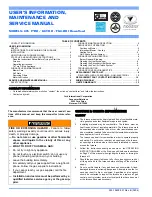
Page 41
Venting Practices
FIGURE 18
* See table20 for allowable pipe.
Piping Suspension Guidelines
NOTE
− Isolate piping at the point where it exits the outside wall or
roof in order to prevent transmission of vibration to the structure.
SCHEDULE 40 PVC −−
Support every 5 feet.
All other pipe* −−
Support every 3 feet.
Wall
inside
outside
24" maximum
3/4" minimum
Wall Thickness Guidelines
If an SLP98UHV furnace replaces a furnace which was
commonly vented with another gas appliance, the size
of the existing vent pipe for that gas appliance must be
checked. Without the heat of the original furnace flue
products, the existing vent pipe is probably oversized for
the single water heater or other appliance. The vent
should be checked for proper draw with the remaining
appliance.
FIGURE 19
REPLACING FURNACE THAT WAS PART OF A
COMMON VENT SYSTEM
CHIMNEY
OR GAS
VENT
(Check sizing
for water
heater only)
FURNACE
(Replaced
by SLP98)
WATER
HEATER
OPENINGS
(To Adjacent
Room)
9. In areas where piping penetrates joists or interior walls,
hole must be large enough to allow clearance on all
sides of pipe through center of hole using a hanger.
10. When furnace is installed in a residence where unit is
shut down for an extended period of time, such as a
vacation home, make provisions for draining condensate
collection trap and lines.
Exhaust Piping (Figures 22 and 23)
11. Route piping to outside of structure. Continue with
installation following instructions given in piping ter-
mination section.
CAUTION
Do not discharge exhaust into an existing stack or
stack that also serves another gas appliance. If verti-
cal discharge through an existing unused stack is re-
quired, insert PVC pipe inside the stack until the end
is even with the top or outlet end of the metal stack.
CAUTION
The exhaust vent pipe operates under positive pres-
sure and must be completely sealed to prevent leak-
age of combustion products into the living space.
Vent Piping Guidelines
The SLP98UHV is installed only as a Direct Vent gas cen-
tral furnace.
NOTE
− In Direct Vent installations, combustion air is taken
from outdoors and flue gases are discharged outdoors.
Intake and exhaust pipe sizing −−
Size pipe according to
tables 22 and 23. Table 22 lists the
minimum
vent pipe
lengths permitted. Table 23 lists the
maximum
pipe lengths
permitted.
Regardless of the diameter of pipe used, the standard roof
and wall terminations described in section
Exhaust Piping
Terminations
should be used. Exhaust vent termination
pipe is sized to optimize the velocity of the exhaust gas as it
exits the termination. Refer to table 24.
In some applications which permit the use of several differ-
ent sizes of vent pipe, a combination vent pipe may be used.
Contact Lennox’ Application Department for assistance in
sizing vent pipe in these applications.
Use the steps in figure 21 to correctly size vent pipe diame-
ter.











































